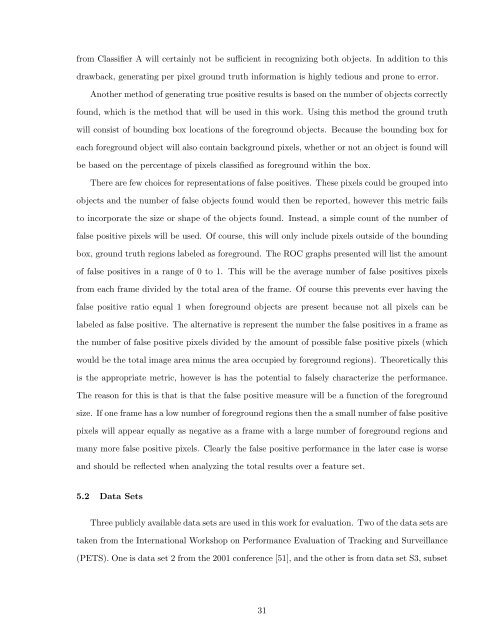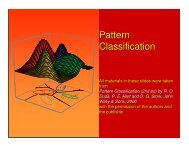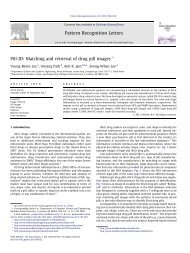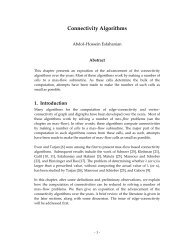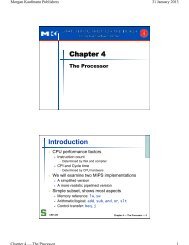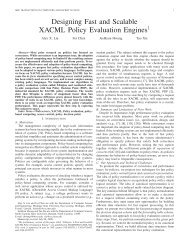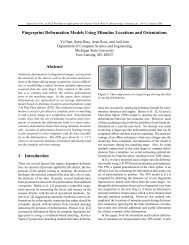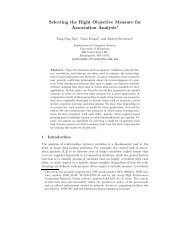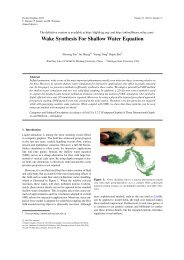Background Subtraction Using Ensembles of Classifiers with an ...
Background Subtraction Using Ensembles of Classifiers with an ...
Background Subtraction Using Ensembles of Classifiers with an ...
Create successful ePaper yourself
Turn your PDF publications into a flip-book with our unique Google optimized e-Paper software.
from Classifier A will certainly not be sufficient in recognizing both objects. In addition to thisdrawback, generating per pixel ground truth information is highly tedious <strong>an</strong>d prone to error.Another method <strong>of</strong> generating true positive results is based on the number <strong>of</strong> objects correctlyfound, which is the method that will be used in this work. <strong>Using</strong> this method the ground truthwill consist <strong>of</strong> bounding box locations <strong>of</strong> the foreground objects. Because the bounding box foreach foreground object will also contain background pixels, whether or not <strong>an</strong> object is found willbe based on the percentage <strong>of</strong> pixels classified as foreground <strong>with</strong>in the box.There are few choices for representations <strong>of</strong> false positives. These pixels could be grouped intoobjects <strong>an</strong>d the number <strong>of</strong> false objects found would then be reported, however this metric failsto incorporate the size or shape <strong>of</strong> the objects found. Instead, a simple count <strong>of</strong> the number <strong>of</strong>false positive pixels will be used. Of course, this will only include pixels outside <strong>of</strong> the boundingbox, ground truth regions labeled as foreground. The ROC graphs presented will list the amount<strong>of</strong> false positives in a r<strong>an</strong>ge <strong>of</strong> 0 to 1. This will be the average number <strong>of</strong> false positives pixelsfrom each frame divided by the total area <strong>of</strong> the frame. Of course this prevents ever having thefalse positive ratio equal 1 when foreground objects are present because not all pixels c<strong>an</strong> belabeled as false positive. The alternative is represent the number the false positives in a frame asthe number <strong>of</strong> false positive pixels divided by the amount <strong>of</strong> possible false positive pixels (whichwould be the total image area minus the area occupied by foreground regions). Theoretically thisis the appropriate metric, however is has the potential to falsely characterize the perform<strong>an</strong>ce.The reason for this is that is that the false positive measure will be a function <strong>of</strong> the foregroundsize. If one frame has a low number <strong>of</strong> foreground regions then the a small number <strong>of</strong> false positivepixels will appear equally as negative as a frame <strong>with</strong> a large number <strong>of</strong> foreground regions <strong>an</strong>dm<strong>an</strong>y more false positive pixels. Clearly the false positive perform<strong>an</strong>ce in the later case is worse<strong>an</strong>d should be reflected when <strong>an</strong>alyzing the total results over a feature set.5.2 Data SetsThree publicly available data sets are used in this work for evaluation. Two <strong>of</strong> the data sets aretaken from the International Workshop on Perform<strong>an</strong>ce Evaluation <strong>of</strong> Tracking <strong>an</strong>d Surveill<strong>an</strong>ce(PETS). One is data set 2 from the 2001 conference [51], <strong>an</strong>d the other is from data set S3, subset31


